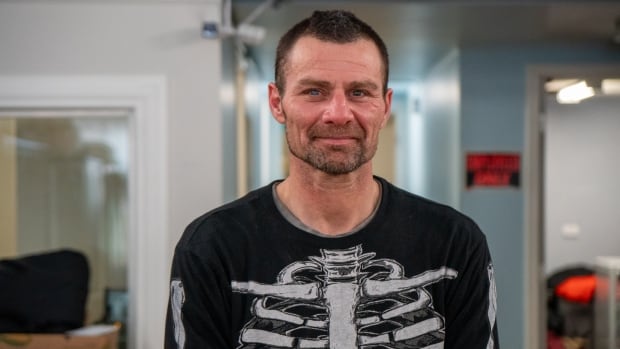Gary Hooper says this is the first time he’s been homeless and it hasn’t been easy.
Living in a tent since moving to Thunder Bay, Ont., two months ago, he considers himself lucky, having warm blankets at night and services he can access during the day. But there are challenges, like not being able to store fresh food and worrying about people stealing his belongings.
“Everybody’s been camping,” he said. “They wanna sleep in the tents. Me, I have no choice right now.”
Hooper has been in recovery from addiction for nine months. He has been volunteering at People Advocating for Change Through Empowerment (PACE), a drop-in centre on the city’s south side, and loves to cook — on Thursday, he made bannock and soup for lunch.

Hooper is just one of a growing number of people experiencing homelessness in the northwestern Ontario city.
Last summer, the number of people known to be sleeping outside nearly tripled compared to the previous year. City council is considering the feasibility of supported or designated encampments, and has directed staff to report back in June about potential sites and costs.
Hooper prefers to keep to himself, but said supported encampments with washrooms, supplies and security patrols are a good idea.
On Friday, Ontario Housing Minister Paul Calandra announced more than $9 million for 52 new transitional housing units in the city. Service providers say they’re hopeful about the much-needed spaces, but concerns remain about how many people will still be in the encampments this summer.
‘Your own privacy is really important’
Longtime friends Shawn Pratt of Thunder Bay and Virginia Rose MacLaurin of Fort William First Nation say they aren’t sure where they’d go if PACE — where they can get coffee, use the computer and watch TV — wasn’t open.
MacLaurin has been homeless since her house burned down more than three years ago.
Pratt was homeless for a year before going to jail, and when he was released six months ago, he had nowhere to stay.
“I’ve been constantly looking for a place since then and they ask you, ‘Have you ever been in trouble?’ and you tell them the truth and then they just shun you away,” Pratt said.
Pratt, who has been in recovery from addiction for nearly three years, is currently staying at an overnight shelter but doesn’t sleep well. His phone was stolen, which meant he lost the numbers of people he was contacting about housing.
“I’ll most likely be in tent city this year again.”

Pratt and MacLaurin said they’d like to see designated or supported encampments.
“I think that’d probably be a pretty good idea if they can monitor it and make sure the people that are supposed to be there only are there,” Pratt said.
“Instead of having five or six people living in a tent or whatever, your own privacy is really important, I think, to be able to lay down by yourself and not worry about anything.”
Health and safety, access to services key
Last year, city council voted to take a human rights-based approach to the encampments rather than removing people from municipal property. Led by Elevate NWO, service providers have been giving out food, supplies and housing applications to those living in tents.
City staff surveyed more than 1,200 people — including the general public, people with lived experience of homelessness, community partners and Indigenous leaders — about the concept of designated or supported encampments.
Cynthia Olsen, the city’s director of strategy and engagement, and policy and research analyst Rilee Willianen presented the findings to council last week.

The majority of people said they were in favour of some kind of designated sites, though responses varied on whether they should provide basic needs or a full suite of support, Olsen said.
Most people in favour of the sites said they should be on municipally owned lands rather than in parking lots or in parks that offer active programming.
“There was a sentiment of wanting to make sure that if there were designated [sites], it wouldn’t mean that people would be forced to those locations or that those designated locations would be so far away from services that are really intended to meet people’s needs,” Olsen said.
Those not in favour of designated sites expressed interest in alternative housing solutions.
Health and safety was also top of mind for all respondents, with rules around garbage pickup and the proximity of designated sites to residences, schools and playgrounds, among other factors to consider, Olsen said.
“People do care about approaching this issue with compassion and kindness, by and large, and it just gives you hope that we can come to a good place when we look towards addressing this issue,” added Willianen.
Human rights-based approach ‘the only way’
Brendan Carlin is executive director of Shelter House, which is open 24/7 and has 62 beds for men and women. It’s a low-barrier shelter, which means people who are intoxicated or impaired aren’t turned away.
Carlin said a human rights-based approach to the encampments is “the only way” to deal with them.
“Having a place where they can go to the bathroom and garbage is taken away, and the service providers around the city are able to know where people are and they can come and see them — that’s really important,” he said.

During last week’s council meeting, Coun. Dominic Pasqualino described concerns about homelessness in his neighbourhood.
“You can imagine what you’d wake up to every morning if there was a homeless person in front of your house, and you know, some are more creepy,” Pasqualino said.
“The one I have in my area is quite creepy. He’ll sit there and stare at your windows for hours.”
There’s a conception that these people are scary, or frightening or violent, and the reality is that’s not true.– Brendan Carlin, executive director of Shelter House
Carlin said that while thefts and fights do happen, most people experiencing homelessness are in survival mode.
“There’s a conception that these people are scary, or frightening or violent, and the reality is that’s not true. They just want a place that they can lay their head at night and get some food and live — and I feel that everybody deserves that right.”
After months of being in and out of the shelter, Pratt said he’s tired.
“It only gets harder and harder every day,” he said. “You’re going to try and get that help, but there’s 40 to 50 people that are also trying to get the help, too.”
For Hooper, who’s headed into his third month of living in a tent, his message is one of perseverance.
“Don’t feel like you’re inadequate because you’re asking for help,” Hooper said. “You’re actually proving strength to ask for help — it’s showing initiative.”





